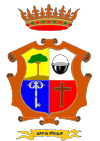Chilluévar facts for kids
Quick facts for kids
Chilluévar, Spain
|
||
|---|---|---|
|
city
|
||

View of Chilluévar
|
||
|
||
| Country | ||
| Autonomous community |
||
| Province | ||
| Municipality | Chilluévar | |
| Area | ||
| • Total | 37 km2 (14 sq mi) | |
| Elevation | 738 m (2,421 ft) | |
| Population
(2018)
|
||
| • Total | 1,459 | |
| • Density | 39.4/km2 (102.1/sq mi) | |
| Time zone | UTC+1 (CET) | |
| • Summer (DST) | UTC+2 (CEST) | |
Chilluévar is a small city in the province of Jaén, Spain. In 2018, about 1,459 people lived there. It is located in the northern part of the Alto Guadalquivir region. The city is also on the edge of the Cazorla, Segura, and Las Villas mountain range.
The land around Chilluévar is mostly used for farming. Olive groves are the main crop grown here. These olive trees cover the hillsides. You can also find other crops near the Vega and Cañamares rivers. The city itself has narrow, sloping streets. Besides the main town, there are smaller areas called Los Almansas, Los Romos, and Chilluevar La Vieja.
Contents
Discovering Chilluévar's Past
The oldest things found in Chilluévar are from the time of the Iberians. These were found in the village of Almansas. Later, the Romans lived here a lot. They built many small farming villages. You can still see some Roman tomb writings in the Provincial Museum.
Chilluévar might be the same place as Alconray, first mentioned in 1256. This was during the Muslim era. It could also be Alcorahe, named in a document from King Juan I in 1384.
How Chilluévar Grew
Chilluévar really started to grow in 1231. At this time, the land became part of the "Adelantamiento de Cazorla." This area belonged to the Archdiocese of Toledo. Two things helped the village develop. First, the Cardinal of Toledo, Don Rodrigo Ximenez de Rada, built many new structures. He wanted to spread the Christian faith in lands taken from the Muslims. Second, the village was on an important path for moving cattle. This path connected Andalusia to Levante for a group called the "Mesta."
In a place now called "Chilluevar la Vieja," a chapel, an inn, a cemetery, and a swimming pool were built. Cattle ranchers, travelers, and merchants would visit the chapel. They rested at the inn and let their animals rest too.
Becoming an Independent Town
Over time, the "Mesta" stopped moving cattle through the area. This caused the old settlement to decline. However, a new church was built in the late 1600s. This new area was called "Chilluevar Nuevo." It was about 1.2 kilometers from the old chapel. In 1787, Chilluévar was officially named a "town" by Cardinal Lorenzana. This showed it was a recognized urban area.
In the early 1900s, Chilluévar worked to become separate from the municipality of Iruela. This long process finished on December 14, 1926. On that day, Chilluévar became its own independent municipality.
Important Places to See
- Parish Church of Our Lady of the Rosary: This is a beautiful church in the town.
- Roman Road and Roman Bridge: You can see parts of an ancient Roman road and a bridge over the Cañamares river.
- Archaeological Remains of Los Almansas: These are old Roman ruins found in the area of Los Almansas.
Chilluévar's Weather
Chilluévar has a Mediterranean climate. This means it has cold winters with a little rain, usually at the end of winter. The summers are warm and dry.
Fun Festivities and Celebrations
Our Lady of Peace Festival (January 24)
Chilluévar shares Our Lady of Peace as its patron saint with two other towns. On January 24, they celebrate with a religious mass and a procession. The night before, people light huge bonfires all over the town. They make these fires from olive tree branches. It's traditional to eat bread with olive oil and roasted potatoes.
San Isidro Festival (May 15)
San Isidro is another patron saint of Chilluévar. This festival is organized by the Fraternity of Labourers. It includes a special working day and religious events. These events honor the protectors of agriculture. You can often find delicious sausages, which Chilluévar is known for.
Our Lady of Peace Fairs and Festivals (September 3-7)
In honor of Our Lady of Peace, Chilluévar holds a fair from September 3 to 7. September 4 is the main celebration day. Besides religious ceremonies, there are bullfighting events with young heifers. A very popular verbena (evening party) also takes place. Here, you can try tasty local mountain food. This includes por sauzales and big game dishes.
Delicious Local Food
Savory Dishes
- Gachas migas: A dish made with flour, often served with bacon and dried peppers.
- Talarines: Dough cakes that can be made with mushrooms and hare or partridge meat.
- Tortilla serrana: An omelette made with a lot of sausage dough.
- Trout: Fresh fish from local waters.
- Lamb with rosemary: Lamb cooked with fragrant rosemary.
- Melojas: A local savory dish.
- Wrought garlic: A garlic-based dish.
- Tortilla de collejas: An omelette made with a wild plant called collejas.
- Ajoharina: A traditional flour-based dish.
Sweet Treats
- Rice pudding: A creamy dessert made with rice and milk.
- Sweet porridge: A warm, sweet cereal dish.
- Papajotes: A type of sweet pastry.
See also
 In Spanish: Chilluévar para niños
In Spanish: Chilluévar para niños





